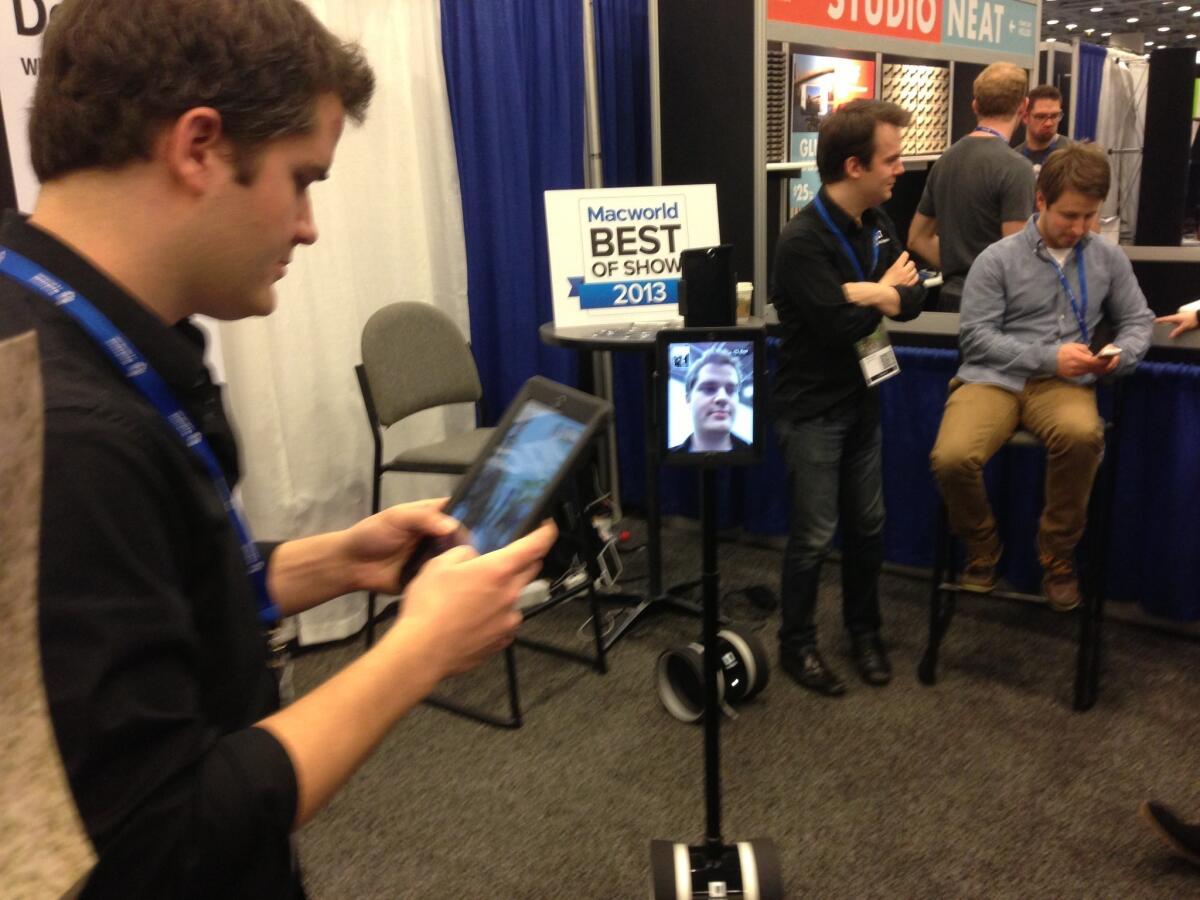‘Can everyone mute?’ Coronavirus means we must telecommute. We’re not ready

On Thursday morning, as the number of new coronavirus cases in California climbed, crates of telecommunications equipment and prefabricated sound isolation booths started arriving at the Playa Vista headquarters of ICANN, the organization tasked with overseeing the deepest levels of the internet.
ICANN, which stands for Internet Corporation for Assigned Names and Numbers, was originally set to hold its March meeting in Cancún, where policy and tech wonks from around the world would convene to hammer out the minutiae of global internet governance.
Instead, they decided to host in Los Angeles what might be the world’s largest-ever working conference call.
Nearly 3,000 people from 150 countries speaking three live-translated languages will participate for four days, with quick-turnaround transcriptions translated into all the official languages of the U.N. to make sure no one is left out of the discussion.
The operation is running on Zoom, the teleconferencing platform whose stock has surged nearly 70% since the beginning of the year in response to the virus-driven demand for telecommuting, augmented by software and systems that ICANN has built over the years to facilitate mass meetings and quick translation.
Although Zoom can handle videoconferences at a large scale, the conference is defaulting to voice-only communications since many participants will dial in from countries with unreliable internet service. Zoom has committed to having its head of operations on standby to help work out any kinks.
When asked whether this emergency operation was guaranteed to go off without a hitch when it begins on Saturday, ICANN Chief Information Officer Ashwin Rangan let out a laugh.
“We are testing out a lot of things in real time,” Rangan said. “We are creating backup plans and plan Cs and testing them all as I speak.”
Translation: Going virtual on this scale is a step into uncharted territory — and a step that more and more businesses are taking in response to COVID-19.
In the last week, companies across the U.S. have started canceling major conferences, halting most business travel and urging employees to work from home in response to the growing viral outbreak in the country. Few will require telecom operations as vast and complicated as ICANN’s, but as companies such as Twitter and Microsoft start shifting to virtual work en masse, the vision of a decentralized work world long promised by telecommuting evangelists is starting to materialize.
But is the technology — and the American workplace — ready to go fully remote?
Even as the tools have improved, with Zoom and collaboration tools such as Slack taking the place of landline conference calls and endless email chains and telepresence robots offering remote workers a chance to amble around the office, the stubborn problem of human error persists.
Stories of getting caught out in pajamas on video calls, or mysterious heavy breathing on mass dial-ins, have become common parts of the work experience as part-time telecommuting becomes a standard feature of office life. Maybe the next generation of remote-work tech, which is likely to include full virtual reality, will solve these hiccups; almost certainly, it will bring new ones.
Shannon Engoian, an ad agency account director, got an unsettling glimpse of the future in the early 2010s, when her firm pitched the company that made the open-ended multiplayer video game “Second Life” — in “Second Life.”
Engoian recalled how her team had to make digital avatars to attend the in-game meeting with the company’s senior executives, then spent some time practicing how to navigate the virtual space.
But when the time for the big meeting came, things did not go as planned.
“This one particular meeting room that they teleported us to for the pitch itself was not a room at all, but was like a bonfire circle on a beach,” Engoian said. “It’s a high-stress scenario, a real pitch with real people, so I’m like nervous, I’m thinking about my speaking roles and stuff.”
The “Second Life” executives appeared in their virtual avatars — Engoian recalls an inflatable frog and a centaur, among others — and the assembled businesspeople sat down on the log benches around the fire to start their meeting.
“My avatar sits down backwards so that her back is facing the rest of the group,” Engoian recalled. Frantic, she tried getting up and sitting down two or three more times, each time with the same result, until her supervisor pinged her AOL Instant Messenger to tell her to give up. At that point, her computer froze. The last her colleagues saw of her was Engoian “flying up and away out of the meeting forever.”
“I was like, ‘Oh my God, I’m gonna be fired over this,’” Engoian said. (She wasn’t, and they won the account.)
While putting on a digital centaur’s skin to hang out in a video game may not seem like work, research has shown that working from home can yield a net increase in productivity.
A 2017 study out of Stanford Graduate School of Business conducted an experiment that found that remote workers at China’s largest travel agency, Ctrip, saw a 13% bump in productivity compared with their office-bound peers over nine months. A similar study from Harvard Business School looked at U.S. Patent and Trademark Office workers who were allowed to go fully remote, rather than having to check in at the office once a week, and found that they ended up 4.4% more productive overall.
Prithwiraj Choudhury, the lead author on the Harvard study, has continued to research remote work in the U.S. and thinks that employee demand, increasing real estate prices and solid technology are combining to make remote work more attractive today than ever. But the key to pulling it off, he’s found, is creating a new culture for remote work.
“You have to create new processes that support remote work,” Choudhury said. Two major problems are syncing over time zones and fostering a sense of camaraderie over distance.
At the patent office, managers brought remote workers into the fold by delivering personal pizzas to their home offices at the same time that they were calling into a pizza-fueled meeting at HQ.
“If you have a team where some people are remote, you need to recognize the pain that remote people go through,” Choudhury said. “Not just the communication loss but also in some ways the different self-identity.”
In recent years, a number of companies have sprung up to solve workplace problems unique to telecommuting.
One of them, Range, builds tools that help teams with no central office coordinate complicated projects, tracking productivity and progress from afar so that managers can shake the feeling that their direct reports are slacking off at home. Twitter, which this week advised all staffers to work from home when possible in response to the virus, is a major client.
“Initially, companies see a benefit when more people go remote, because people aren’t interrupted as much,” said Range co-founder and Chief Product Officer Braden Kowitz. “Then, they start to notice communication breaks down. Then the third thing is that the culture breaks down.”
To solve the communication problem, Range augments its progress-tracking tools with strong meeting facilitation practices drawn from design critiques and old-fashioned handbooks such as “Robert’s Rules of Order” — opening with a round-the-table icebreaker to get everyone talking, sticking to clear agendas and only allowing people to speak in strict order so that everyone gets to talk.
To address the social issue, Range had to get a little more creative, building in features that replicate the kind of water-cooler socializing and team bonding that happens when people occupy a shared space.
The company offers a feature that includes 350 questions that teams can use as jumping-off points for nonwork conversations, starting with anodyne questions such as where people went on recent vacations and then ramping up to more thoughtful, personal questions like how people approach risk, and how they see their clothes reflecting their personalities.
“We looked at ways for teams to build psychological safety and trust,” Kowitz said. “If you’re a team you have to be able to ask each other for help, and in order to ask for help you need to be vulnerable.”
Zapier, a 300-person company whose software automates tasks between web apps, has been fully remote since its start in 2011. Its founders have become evangelists for remote working over the years, commissioning reports on the practice, publishing their Slack etiquette guide as a model and serving as informal advisors to companies considering that path.
“It’s allowed us to tap into a global talent pool in a way nobody else can,” said Wade Foster, Zapier’s chief executive.
The company has kept to its remote-work roots as the software for conference calls and office chatting has changed, and Foster chalks up its success to a few core practices. Zapier has a budget to set up all new hires with a kitted-out home office, requires all meetings to be full video calls, and has a strong onboarding process that teaches employees how to use their customized version of Slack. And it makes sure that everyone writes everything down.
“It takes a level of discipline to document what is going on in the org that many in-office cultures don’t have,” Foster said.
But even in a company that does everything right, not every tech worker is cut out for a fully remote life. Foster said that some potential Zapier recruits have balked at the lack of an office.
“More times than not they end up being successful in the company,” Foster said. “The few times where it doesn’t, I’d say it tends to be with folks who use work as their social outlet.”
And for those who prefer a compromise between the virtual and tangible worlds, there are always robots.
Double Robotics is one of the leading U.S. manufacturers of “telepresence” robots, which display a video feed of a telecommuting worker on a screen attached to a Segway-like wheeled contraption that can be driven remotely. Double’s chief executive, David Cann, says the company has been seeing a surge in orders as coronavirus fears ramp up across the country.
“We’re trying to catch up on orders. We have a backlog now and we’re trying to build as fast as possible,” Cann said.
But the same virus that’s prompting an uptick in orders is posing some problems for the company. The broad shutdown in China, where the original outbreak took place, has squeezed the supply chains that Double relies on to build its products at its Burlingame, Calif., headquarters.
That technology, however, has improved. Until last year, the Double was still essentially a tricked-out ride for an off-the-shelf Apple iPad. Users had to manually steer the Double around the office, and inept driving could get its wheels stuck on a doorframe.

“It wasn’t a big deal, but it’s a little bit embarrassing,” Cann said. But the 2019 model, the Double Three, comes with a built-in tablet screen and has enough sensors that users can just point and click where they want to go within the robot’s field of vision. The Double will glide on over, avoiding objects and edges along the way.
As with other remote working technologies, Cann said that building an office culture around their robots is the surest indicator of a successful transition. Most important, remote workers and all of their co-workers need to be on board with the robot concept.
“For the first day or two, it’s going to be a total novelty — you need to get everyone around and ask all the crazy questions and get that out of the way first,” Cann said. “The next day, it’s just like, ‘Oh, that’s Joe on the robot.’”







